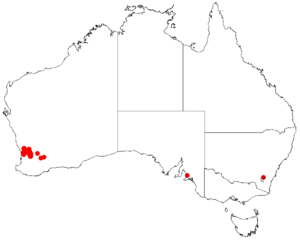Acacia meisneri facts for kids
Quick facts for kids Acacia meisneri |
|
|---|---|
| Scientific classification | |
| Genus: |
Acacia
|
| Species: |
meisneri
|
 |
|
| Occurrence data from AVH | |
Acacia meisneri is a special type of shrub. It belongs to a large group of plants called Acacias, which are also known as wattles. This particular acacia grows only in a specific part of Western Australia. It's a unique plant found nowhere else in the world!
Contents
What Does Acacia meisneri Look Like?
This shrub is usually quite bushy and can grow between 1 and 4 meters (about 3 to 13 feet) tall. It often has a rounded or funnel shape. Its branches are smooth and often have a fine, white powdery coating.
Leaves and Flowers
Like most Acacia plants, Acacia meisneri doesn't have true leaves. Instead, it has what are called phyllodes. These are flattened leaf stems that look and act like leaves. The phyllodes are grey to grey-green. They can be oval, spear-shaped, or egg-shaped. They are usually 15 to 40 millimeters (about 0.6 to 1.6 inches) long. They are also 5 to 15 millimeters (about 0.2 to 0.6 inches) wide. Each phyllode has one main vein and a powdery white coating. This plant usually blooms from November to February. However, you might see its flowers at other times of the year too.
How Was Acacia meisneri Named?
Scientists give every plant a special name. This helps everyone know exactly which plant they are talking about.
The Naming Process
The first official description of Acacia meisneri was in 1842. It was described by a scientist named Johann Georg Christian Lehmann. Later, in 1844, another scientist, Carl Meissner, also described it. For a short time in 2003, it was called Racosperma meisneri. But in 2006, it was moved back to the Acacia group. This shows how scientists sometimes change plant names as they learn more.
Where Does Acacia meisneri Grow?
This unique shrub is found only in the Wheatbelt area of Western Australia.
Its Natural Home
Acacia meisneri likes to grow in different types of soil. You can find it in clay, sandy, or loamy soils. Sometimes it even grows in rocky areas. It is mostly found in the area around the Avon River. This is from a town called Goomalling in the north to Brookton in the south. You can often see it on flat plains, near rivers and streams, and along roadsides. It often grows alongside Eucalyptus wandoo trees, which are another type of gum tree.

